Film Name:蜘蛛俠:平行宇宙 / Spider-Man: Into the Spider-Verse
Despite having raised my expectations significantly after seeing countless rave reviews, “Spider-Man: Into the Spider-Verse” still far exceeded my anticipation after watching it! It’s not only the best animated film of the year but will undoubtedly carve out a place in the history of animated cinema.
And let’s not forget—it’s a Spider-Man movie… Truly, every inch of this film is brimming with surprises.
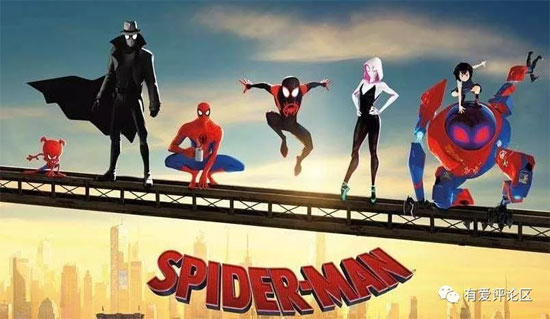
Putting into words just how good “Spider-Man: Into the Spider-Verse” is proves quite challenging. Many of its visual and auditory effects, along with the sensory experience, simply defy translation into text. The best advice? Go see it for yourself. Trust me, you won’t be disappointed.
[Friendly reminder: Spoilers ahead.]
The greatest strength of Spider-Man: Into the Spider-Verse lies in its uniquely distinctive visual style.
First, it’s a 3D animated film, yet you’ll notice it brims with comic book elements throughout: speech bubbles, monologue panels, halftone dots, stylized onomatopoeia, and even “Kirby blasts”—circular patterns representing cosmic energy—all employed to create a novel “reading experience” while watching the movie.
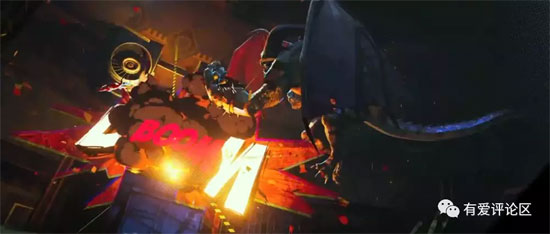
This isn’t a simple case of forced adaptation. Such a bold approach, if mishandled, could leave audiences with a jarring sense of incongruity, easily resulting in a disjointed, hybrid mess. To refine and integrate this unique visual style, the film underwent a radical “dimension reduction” process on top of its 3D animation foundation. It employed a technique of overlaying CG with hand-drawn lines, ensuring the retention of comic-book characteristics while preserving the original texture of the animation.
Such unconventional production naturally demands sacrifices: after blending textures from different “dimensions,” the film deliberately lowers its frame rate. Scenes running at 12 frames per second are commonplace, accompanied by ‘issues’ like thick outlines, color bleeding, and blurriness—elements that may unsettle some viewers… Yet this deliberate “roughness” is precisely the effect the film strives to achieve.
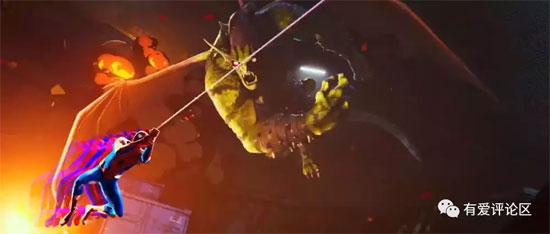
Beyond evoking the sensation of “comics being transposed onto the screen,” this visual style also mimics the “out-of-focus” effect commonly encountered in photography and cinematography—an ‘issue’ rarely seen in traditional 2D animation, 3D animation, or stop-motion animation. This further imbues Spider-Man: Into the Spider-Verse with its distinctive “live-action” quality.
Modern comics possess strong cinematic qualities and lend themselves well to animation largely because they borrow from film’s storyboard techniques. The film takes this a step further by “reverse-engineering” the process, employing comic-style panel layouts that not only create visual impact but also enhance the narrative.

While I’m not particularly knowledgeable about music, I must admit the score for “Spider-Man: Into the Spider-Verse” is superb. Crucially, it perfectly complements the film’s style—that confident, unrestrained, free-spirited vibe paired with dazzling, kaleidoscopic visuals delivers an absolutely exhilarating audiovisual feast.
Of course, it must be acknowledged that this eclectic, hybrid style won’t appeal to everyone (especially in China), so there’s no need to criticize viewers who can’t appreciate the film’s visual approach.
The creators likely anticipated this, which is why they never hold back when it comes to delivering the full “3D” experience.
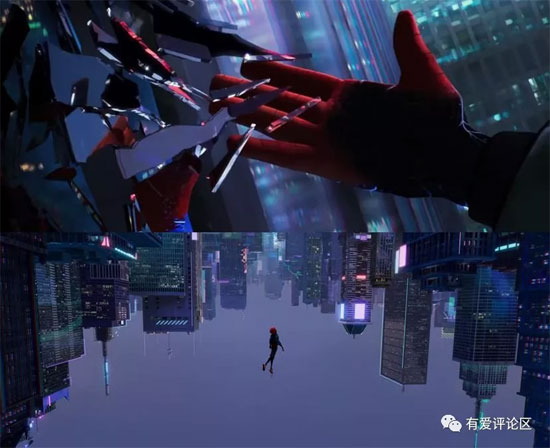
Take Miles’s “leap of faith” after finding himself and before heading into battle—the hair-thin texture of the lines represents the pinnacle of current 3D animation.
The uniquely distinctive visual style of “Spider-Man: Into the Spider-Verse” owes much to its six Spider-Men from different universes, who infuse the film with richer, more vibrant genre elements: Miles Morales and Peter Parker form the foundation, as previously discussed; Gwen Stacy builds upon this with subtle modifications, contributing a more delicate and fluid aesthetic; Spider-Man Noir’s stark black-and-white attire radiates hardcore retro flair; Penny Parker’s richly anime-inspired look embodies the most familiar “ACG” aesthetic; while Spider-Ham delivers classic cartoon charm while providing plenty of comic relief.
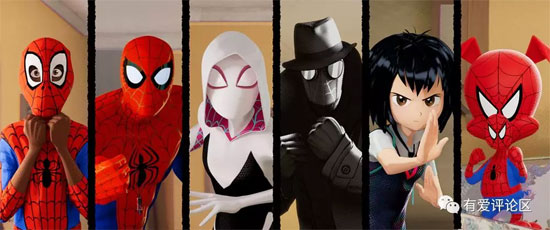
Here, one must admire Sony’s ingenuity: Compared to Marvel Studios’ Avengers and Fox’s X-Men franchises, Sony’s position holding only the Spider-Man rights was rather awkward. The previous Amazing Spider-Man films underperformed, and under Marvel’s unrivaled dominance, they co-developed the young Spider-Man… Reviving Spider-Man as a cash cow was no easy feat.
“Spider-Man: Into the Spider-Verse” took a bold, unconventional approach. Despite initial skepticism, it masterfully played its hand by embracing the multiverse concept—a truly commendable move. The message was clear: “You have countless heroes? Well, I have multiple Spider-Men. With just one character, we can achieve a synergy where 1+1>2.”
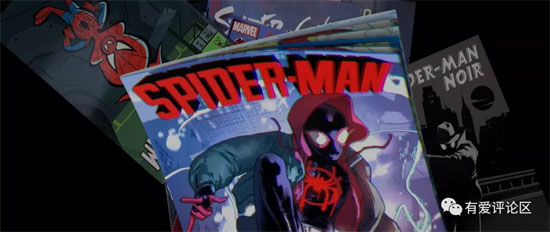
The film not only embraces this aspect but flaunts it, embedding countless Easter eggs throughout—interested viewers can consult more specialized lists. My advice remains: discovering each hidden gem adds to the fun, but missing a few won’t detract from your viewing experience.
Having covered its production strengths, let’s turn to the narrative.
First, the verdict: “Spider-Man: Into the Spider-Verse” has no major flaws in its storytelling. Both main storylines are well-handled. While the pacing feels slightly uneven in the early to mid-section, it doesn’t disrupt the overall narrative flow. The film maintains a solid foundation, avoiding the pitfall of being “visually stunning but plot-weak.”
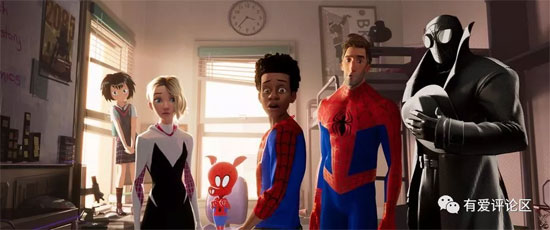
The film centers on Miles Morales as its primary protagonist, inheriting the mantle of Spider-Man in the main universe. A “decadent” Peter Parker serves as the first male supporting character, with Gwen Stacy taking the secondary female lead role. Shadow Spider-Man, Penny Parker, Spider-Ham as the next tier, masterfully balancing the narrative weight and pacing.
The narrative core centers on mentor Peter guiding rookie Miles—one evolving from a clueless newcomer into a capable hero, the other rejuvenating a washed-up middle-aged man—fully embodying the “growth” theme. Gwen expands this theme on another level, while the remaining trio serve as flavorful additions, enhancing the film’s genre elements.

While “six Spider-Men sharing the screen” is the film’s biggest draw, it remains a feature under two hours long. The creators inevitably had to make choices, meaning not every Spider-Man could have extensive screen time… Minor disappointments are inevitable, but unavoidable.
On another narrative thread, the film remains true to the core essence of the Spider-Man franchise.
Miles’s love and protection for his family serve as his starting point and driving force. The death of Uncle Ben (the Vagabond) forces Miles to confront the pain of losing a loved one and the price of growing strong.

In comparison, the family subplot feels somewhat conventional and slightly superficial. Fortunately, it doesn’t dominate the narrative and doesn’t detract significantly, so it’s neither a major strength nor weakness.
What brings me comfort is that following Peter Parker, another new-generation Spider-Man has been successfully brought to life on screen—Miles Morales, the “Black Spider-Man,” is utterly convincing. (You mention Spider-Woman Gwen Stacy? Fair enough, I admit she’s fantastic too, but today isn’t her spotlight.)

Just like the graffiti he spray-painted on the Spider-Man suit after inheriting it, Miles embodies a distinct style and personality: beneath his gentle and humble exterior lies a rebellious streak. He is sensitive and kind, honoring his promise to his predecessor, yet careless and carefree—always leaving his shoelaces untied. He carries all the inescapable worries and laziness of adolescence, yet also holds the dreams and convictions his peers yearn for.
After navigating his uncertainties, Miles found his own path. Just as Stan Lee, the “shopkeeper,” told him when buying his first cosplay suit, worried it might not fit: “One day it will.”
He isn’t the second Peter Parker—he is the first Miles Morales.

What truly inspires in “Spider-Man: Into the Spider-Verse” is this spirit: “Anyone can be Spider-Man!” Because each of us can be a hero to ourselves and our loved ones.
Please specify:Anime Phone Cases » Spider-Man: Into the Spider-Verse 蜘蛛俠:平行宇宙 2018 Film Review: Unparalleled benchmark in animation